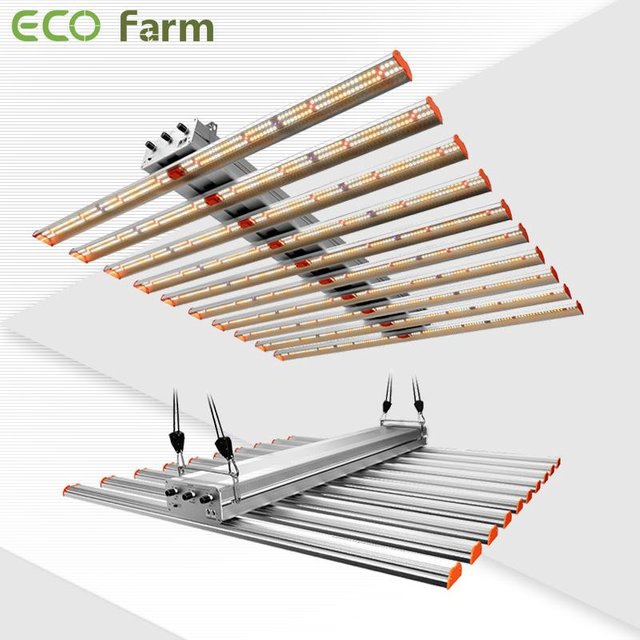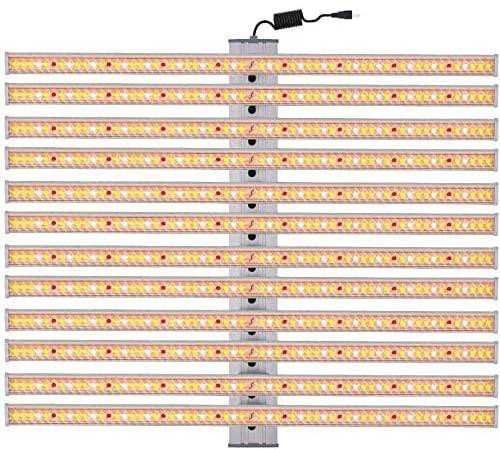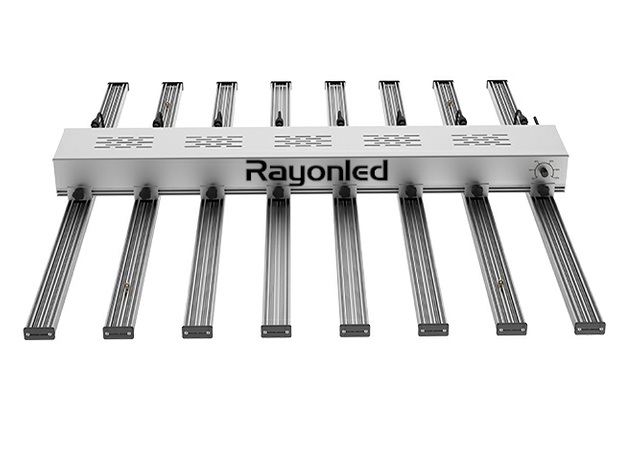HPS vs. LED : Which is Better?
Introduction
Deciding on what growing lights to use in your indoor garden is a major decision, with trickle-down effects not only on your potential harvest but the entire operational setup. Today, there are two main types of indoor grow lights to choose from, high-pressure sodium lights (HPS) or light emitting diodes lights (LED). The ongoing debate between the two very different lighting options is fierce with experts weighing in on both sides. But recently, as LED lighting companies continue to make improvements to their products, the tide is moving in their favor.
Why is making the switch to LED making more sense for indoor growers than ever before? In recent years, the upfront costs for LED lights have dropped dramatically, technologies have improved to better harness the science of light, and producers recognize the energy-saving potential of LEDs.
Many indoor gardeners were wary of LED lighting options in the past because they had experienced older, outdated versions, released well before many of the current innovations were around. But today, even long-time growers are deciding to switch from HPS setups to more technologically advanced LED options; the pro-LED arguments are more and more convincing.
What are HPS and LED lights?
HPS lights emit light by sending a pulse of high-voltage energy through a pressurized quartz tube filled with vaporized sodium, along with other elements such as xenon and mercury.
As the gases heat, they emit light. Sodium produces an intensely yellow-orange light; this can be mediated by xenon and mercury, both of which emit light in the blue end of the visible spectrum. The final result is whiter light.
LED lights are semiconductors, which allow electrical energy to pass with little resistance in one direction and overwhelming resistance in the other, across a “p-n junction”.
On one side of the junction is a material that has been treated with extra electrons, while on the other side is material that has been treated to lack electrons. When voltage is applied, the extra electrons move across the junction to fill the “electron holes” on the other side.
This causes light to be emitted, the colour of which varies according to the material used. Phosphides and nitrides of gallium, aluminium, zinc and silicon are the most commonly-used materials.
Comparing LEDs and HPS Lighting
Generalizations about LEDs — or HPS lamps, for that matter — lead to some bad conclusions. With horticultural lighting, it’s all too easy to make apples-to-oranges comparisons. That’s why many growers have had disappointing experiences with LEDs in the early years.
LEDs have varying efficiency ratings, depending on the product, and that dramatically affects how much light they’re producing. It’s the same with HPS. When we talk about HPS technologies in general, we gloss over important design elements like (1) the wattage of the fixture, (2) whether the lamp is single- or double-ended, and (3) whether the ballast is magnetic or electronic, etc.
For instance, an HPS fixture may achieve an efficiency of 1.7 µmol/joule if it’s a double-ended lamp with a 1000-watt electronic ballast. But a different, 400-watt HPS light with a magnetic ballast is a different story. The 400-watt will only score an efficiency rating in the 1.0-µmol/joule range. Essentially, we’re talking about different technologies and calling them both “HPS.”
LEDs are much the same. Though they’re generally more efficient than HPS (with some clocking 2.8 µmol/joule), some LEDs are less efficient than high-quality HPS fixtures, and they give you less light. You’ll find the LED fixtures vary in efficiency based on (1) the type of diodes, (2) the color composition of the spectrum, (3) the product’s overall quality, and other engineering factors. What’s more, even if the µmol/joule efficiency is high, an LED fixture may not have the spectrum to give your plants good morphology, as explained below.
You may also find some hidden inefficiencies lurking in the ballasts of HID fixtures. All too often, the µmol/joule rating on HPS products states the lamp efficiency, not the actual product efficiency. The lamp may perform well in a laboratory setting based on the wattage provided, but when the electrical loss of the ballast is factored in, the efficiency numbers begin to look very different. The reflector hood also decreases the stated efficiency of an HPS fixture.
In truth, efficiency goes beyond electrical consumption. Well-engineered lighting products will provide you with better harvest outcomes for several reasons. For instance, when you give your plants a balanced, fine-tuned spectrum, you can expect an increase in secondary metabolites and larger crops of denser flowers. And electrical efficiency means lower heat, which creates a cascade of cost-reductions due to reduced HVAC use, fewer circulating fans, and easier pest management.
The following recommends you 3 best LED plant growth lights, I hope it can be helpful to you.
ECO Farm ECOZ 1000W Samsung 301H Chips LED Grow Light With Separately UV+IR Control
Features:
ECO Farm LED grow light: Input power: 1000W. High PPFD. Redefine the project. The true full-spectrum LED growth light bar is hydroponic from vegetables to flowering, suitable for indoor plant growth. Ideal for beginners or professional growers
Full spectrum-We have done a lot of experiments to ensure that this full spectrum design promotes plant growth. It includes general-purpose blue, white and far-infrared lights, which provide everything that plants need under natural light. Warm white sunlight LED can promote the photosynthesis of plants, and blue and red LEDs are essential light for plant growth.
LED grow lights will provide high performance, long-lasting and energy saving, suitable for general use. Our LED plant grow lights will record breakthrough developments in cultivation speed and quality.
Silent growth: No fan design makes the planting box so quiet. Coverage area: 5'x 5'or 6'x 6'
Durability: high-end high-performance self-heating structure, long service life.
Aceple AG-6000 660W LED Grow Light Fixture with Osram Chips
Features:
Industry Top Efficacy for More Lights and Less Heat — — Equipped with with Osram DURIS LED, results in an efficacy of 2.5 µmol/J and a 1650 μmol/s PPF which benefit you with more lights, less heat, lower electricity bill.
Enhanced Full Spectrum for Higher Yield — — Red, white and warm white (660nm, 6000K, 2700K) provide accurate and useful light for plant growth provide plants in all stages from seedling to harvest with everything they need in the natural sunlight which results in bigger buds and higher yield.
Reliable Passive-Cooled Design for More Light and Longer Lifespan — — Built with passive heat-sink (fanless) which converts electric energy into more light. Fanless design benefits you with longer lifespan. Recommended for grow tents, grow rooms, soil, hydroponic, aeroponic, or aquaponic systems.
Friendly use, wide coverage — — Not only plug and play, but you can install it in a quarter. This 40"x40" large grow light is perfect for growing tents of 4x4 feet or 4x5 feet. If there is no tent, it is recommended to cover a 5x5 foot seedling growth area and a 4x3.5 foot best flowering area.
Rayonled GLM 720 LED Grow Light
Features:
Maximize output and energy saving-with upgraded IP65 chip and SAMSUNG LM301B top binary diode, 6 passive cooling bars, higher light intensity, less light attenuation, better lumen and Par value. Compared with the old plant lamp, the output per watt can reach up to 2.6 grams, the average PPF is as high as 1 872 μmol, and the output and quality are increased by 50%.
Flexible and dimmable growth lamp and full spectrum-with ultraviolet and far red light bars, it can provide the most complete spectrum on the market! The independent light bar and driver ensure that even if there is a problem, the light can be repaired without affecting the production of the entire luminaire.
Amazing heat dissipation and external power supply-The light board adopts sealing technology, so the whole plant growth light is waterproof. The IP65 certification allows the light to function and continue to function even in the wettest growing room, without worrying that the humid planting environment will damage the light of the plants.
Structural optimization and material upgrades make it lighter and easier to install and use. No noise design, no need to worry about noise, very suitable for planting houses and planting tents.
Advantages of LEDs over HPS
Efficiency — LED diodes are very electrically efficient, which could save you money over time (though the jury is still out when it comes to whether LEDs get better yields than HPS watt-for-watt). Additionally, where an HPS bulb needs to be replaced every few grows to maintain its brightness, individual LED diodes keep their brightness practically forever. With an LED grow light, it’s almost certain something else will break on the lamp before any diodes start losing their brightness.
Plug-And-Play — LED grow lights are plug-and-play which means you can simply hang up the lamp over your plants and plug it directly into any standard electrical socket. HPS lighting requires the use of a ballast; for smaller models it can be built-in, but larger HPS lights generally need a brick-sized external ballast.
LED Grow Lights Come With Built-In Cooling — Along the lines of being totally plug-and-play, most LED lamps have heatsinks and small built-in fans to help disperse heat up and away from the lamp, which lets them run cooler. On the flip side, even a small HPS bulb needs extra help for cooling, usually by venting out hot air using a fan and ducting.
Customized Color Spectrum — It is known that the color spectrum of light affects how plants grow. Unlike other grow lights which are pretty set in their color spectrum, each LED diode can be configured to emit light of a very specific color spectrum chosen by the user. This means that LED grow light color spectrums can be adjusted and customized in a modular way that’s impossible to achieve with any other grow light.
The Stages of Growth
Seedling Stage: HPS vs LED
From the point of germination, seedlings are at there most vulnerable during their initial growth into juvenile cannabis plants. Too intense lighting impacts them negatively, as they don’t have the foundation to support such bright light.
LEDs can also be ideal for this stage of growth because of their full-spectrum capabilities and dimming options. Their low heat emission also allows them to be placed above your precious seedlings without harming them.
HIDs, such as HPS and MH are both not as ideal for seedlings as they are during the later stages of growth.
These high-watt lamps would need to placed rather high from the canopy to not do any damage, and even if they have a dimming option, they will still need to be a fair distance away.
HIDs tend to be kept in the closet until the later stages of growth when the plant has enough leaves that can actually benefit from the high light output.
Vegetative Stage: HPS vs LED
This stage includes juveniles that have at least 3 nodes. The vegetative stage is an integral part of the cannabis plants’ lifecycle since it lays the overall foundation.
The leaves grow, and the root system expands, and the photosynthesis required from the lights is as crucial as ever.
HID Lighting System (Vegetative Stage)
HIDs, such as HPS and MH are great for this stage if you’re looking for efficiency. The growth rates increase with the added watts from HIDs, and the dimming option can come into use at this point. On the other hand, since the vegetative stage requires 18 hours or more of light, the power from HIDs will mean a massive electricity bill. Some claim that MHs are better than HPS during the vegetative stage because of their blue and white wavelength.
According to studies, the blue wavelength is associated with summer light, when cannabis naturally grows during its vegetative phase. This makes using MH over HPS more appealing.
LED Lighting System (Vegetative Stage)
LEDs might be the most ideally suited for the vegetative stage because of minimal heat and electricity costs. The long periods of light required to make for this efficient system to shine.
Flowering Stage: HPS vs LED
This is the stage every grower waits for. Although all previous stages contribute to the overall flowering stage, it’s essential to make the best environment possible for a bountiful harvest.
HID Lighting System (Flowering Stage)
HIDs are potentially the best lighting method for this stage. Studies show that cannabis reacts better to the red and orange wavelength of HPS because it mimics the sun during its transition to the Fall season.
Fall is associated with a lower sun on the horizon due to shorter days, and cannabis naturally flowers at this point to make sure it becomes pollinated.
This rush for pollination forces the female cannabis plant to push out ever more pistils to find pollen. Since we grow cannabis with only female flowers, they increase in size giving us the big buds we seek.
The disadvantage of HIDs in general, whether MH or HPS, is a large amount of heat they produce. The growing buds are vulnerable, and increased heat stress can diminish their yield.
MHs can still be used with excellent results, but there may or may not be a significant difference in bud production. Regardless of HID choice, these wattage-machines won’t fail to yield abundant and resinous buds.
LED Lighting System (Flowering Stage)
LEDs can optimally be used during the flowering stage. Since many LEDs are digitally variable, users can select an all red diode spectrum.
This flexibility from blue to red without having to buy additional bulbs may be a game changer for those on a budget.
LEDs are capable of yielding similar harvests to that of HIDs. This is generally the case when the grower is exceptionally experienced because the lower wattages from LEDs tend to create medium sized harvests.
Conclusion — HPS is Good, LED is Better
Virtually any type of artificial light has, at some point, been used for horticultural purposes. Since greenhouse operators and the space agencies both share an interest in determining which light sources produce the best results while consuming the fewest resources in terms of energy (to run the light and to cool the grow area) and grow space and cooling, a large number of studies have been, and will be, conducted to determine which artificial light sources are the most effective and efficient.
Since high-pressure sodium lights produce an intense light at a relatively low cost, they are widely used in horticulture. However, they do not emit the ideal combination of colors and they also produce a large amount of heat. As a result, more energy is needed to run the lights and even more to cool the growing area. Furthermore, the lights must be kept far from the canopy to prevent leaf-burn.
LED grow lights, on the other hand, require less electricity to run and, due to their lower production of excess heat, less electricity to keep down the temperature of the grow space. They lower heat also means no burn damage to plants — in many cases, even when there is extended leaf-on-bulb contact. Finally, LED fixtures can be customized with the optimal ratio of colors for plant growth. All of this means you get better growth and higher yields at a much lower cost.
Finally, I just want to add that there are some key differences you need to be aware of in growing with LEDs. Most first time LED growers are not aware of them and they end up with very disappointing results.


